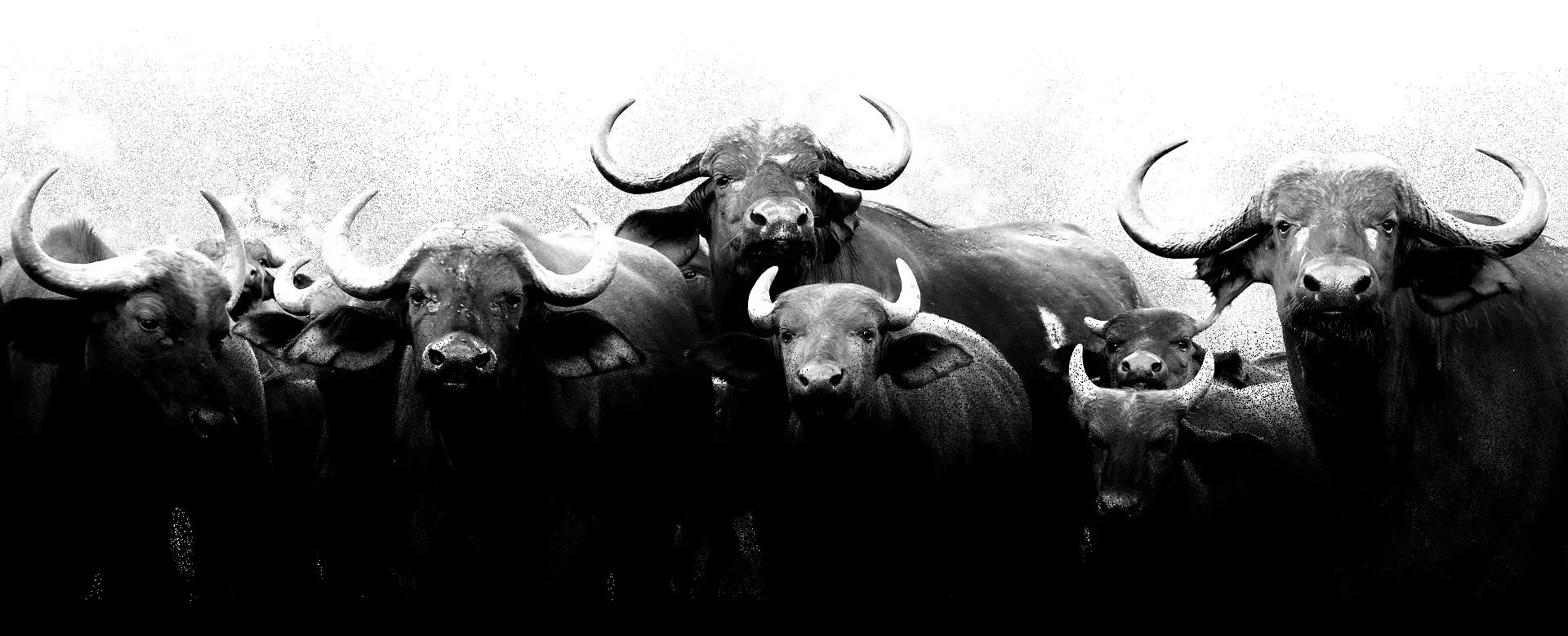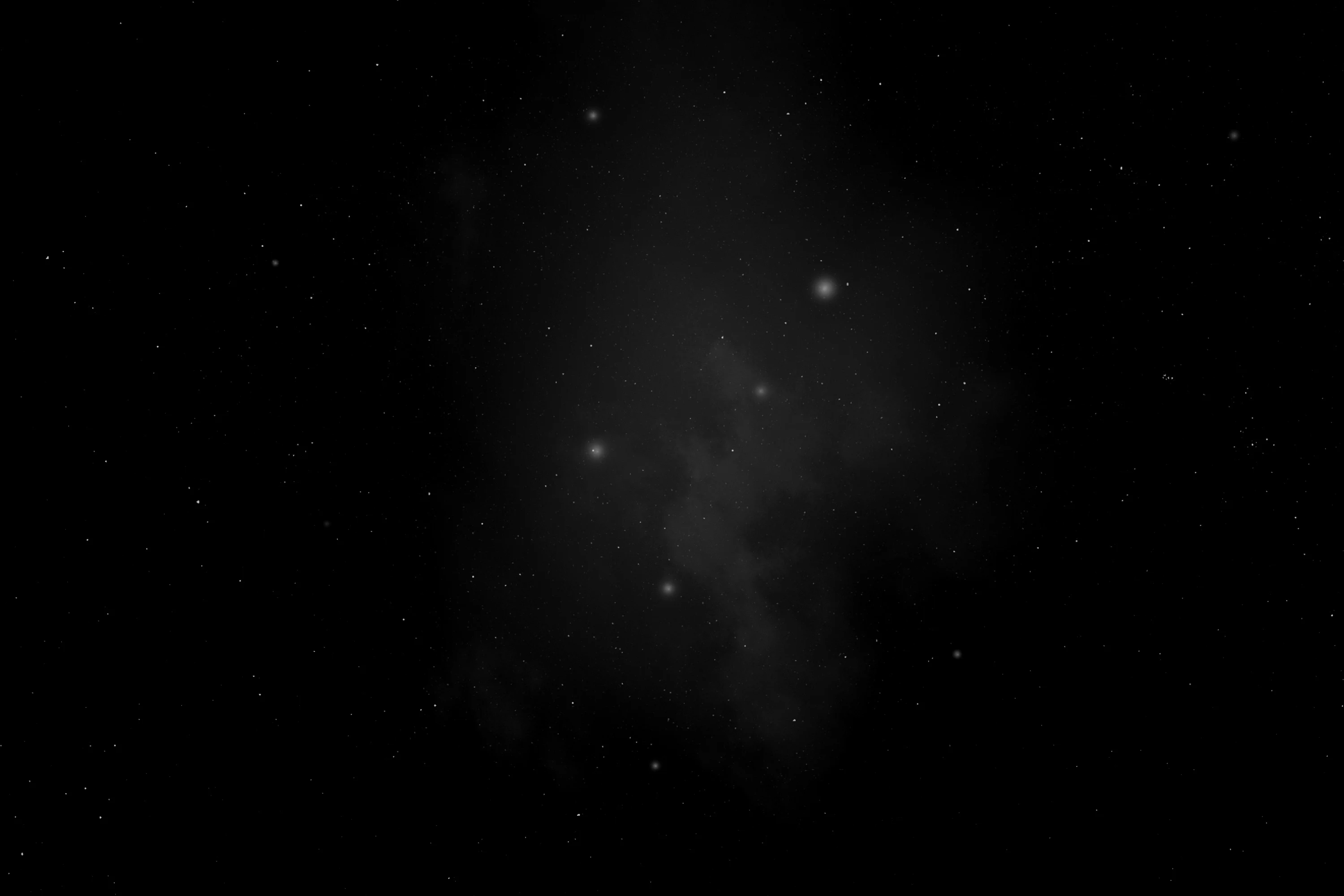
(Peramelemorphia)
Bandicoots and Bilbies
Бандикутоподібні
The order Peramelemorphia includes the bandicoots and bilbies, consists of 22 species that are divided among 7 genera and 2 families. They have a rodent-like appearance with short legs, a stocky body, a short neck, and a long, pointy nose. They are largely nocturnal, and possess a well-developed sense of smell and eyes that are well adapted for night vision. Most peramelemorphs have brownish-red or tan fur and are sometimes marked with stripes. Long, rabbit-like ears also characterize some species. They range in size from less than 100 g to over 5 kg, though most are about the size of a rabbit or smaller. Peramelemorphs are omnivores that eat mainly insects, but also consume a variety of vegetable material and some vertebrates as well. They occupy a wide range of habitats throughout Australia, New Guinea, Tasmania and the surrounding islands.
Peramelemorphs occupy a wide range of habitats, with altitude and climatic differences heavily influencing the distribution of species. Members of the family Peramelidae inhabit a variety of ecosystems, ranging from deserts to subalpine grasslands to tropical lowland rainforests, while thylacomyids primarily live in arid areas. Eastern barred bandicoots and the now extinct pig-footed bandicoot prefer grassland habitats, golden bandicoots inhabit the Top End and Kimberly tropics of Australia, brown bandicoots live in more secluded forests and the only living species of bilby, the greater bilby, is a desert-dweller. By occupying a wide variety of habitats and vegetation types, bandicoots and bilbies largely avoid competition. In New Guinea, peramelemorphs (Peroryctinae) are distributed throughout a wide range of altitudes. However, several species may occur sympatrically at moderate altitudes. The northern brown bandicoot, giant bandicoot and most species of spiny bandicoots prefer lowland areas, though some may live as high as 2000 m. Mouse bandicoots, striped bandicoots and Raffray’s bandicoots are upland species and typically live at elevations above 1000 m. There is one known high altitude species, Seram bandicoots, that are only found at altitudes of around 1800 m.
Physical Description
Members of the order Peramelemorphia are terrestrial, ground-dwelling mammals. They range from 15 cm in length (excluding tail) and 100 g in weight to 60 cm in length and 5 kg in weight. Their bodies are compact in size with relatively short tails compared to the length of their bodies, except in the case of the greater bilby, which possesses a long, brush-like tail. Peramelemorphs have short necks, elongate skulls, and long, tapered snouts. Their ears are upright and can range from being small and rounded to fairly large and pointy. Males are usually larger than females and are socially dominant.
The hind limbs of peramelemorphs are relatively long and exceptionally powerful. On the hind feet, the forth toe is the largest, while the bones of the second and third toes are fused, but still maintain separate claws (i.e., syndactyly). The front limbs are very short and well-adapted for ground foraging and digging. The first and fifth toes on the forefeet are either absent or lack claws if present. The second, third, and fourth toes have strong, flat claws for digging. They typically use their strong hind limbs to leap and hop through brushy habitats; however, when escaping danger they are able to run at a fast gallop. Their front and back legs work alternately. Characteristically, they land on hind and forefeet, and then take off with a push of their large hindfeet.
Members of the order Peramelemorphia can be most noticeably recognized by their unique marsupium, the pouch located on the venter used to carry immature young. Unlike teh marsupium of kangaroos and wallabies, the marsupium of peramelemorphs opens to the rear. Although this condition is present in some diprotodonts (e.g., wombats), it is probably uniquely derived in each lineage.
Peramelemorphs are omnivorous and their dentition is well-suited to a diet consisting of plants and insects. Unlike diprotodonts, which have only 2 lower incisors, peramelemorphs are polyprotodonts, having multiple lower incisors and anywhere from 4 to 5 upper incisors. Their incisors are flattened at the tips with the crown of the last lower incisor having two lobes. The canines are present and well-developed and they also have 3 premolars, which are narrow and pointed (plagialacoid) and 4 molars, which are tribosphenic or quadrate, in the upper and lower sets. This gives them the dental formula of 4-5/3, 1/1, 3/3, 4/4 = 46 or 48.
Reproduction
Direct observations of mating in peramelemorphs are rare, however, based on behavioral data they are probably either polygynous or promiscuous, and females are polyestrous. Although peramelemorphs are solitary, male territories overlap with those of several females, and during mating season males spend a majority of their time searching for receptive females. Once they find an estrus female, they follow the potential mate until she is ready to be mounted. Females may mate with more than one male if the opportunity presents itself.
Peramelemorphs are known for their accelerated breeding process, which enables a single female to give birth to as many as 16 young per year. Unlike all other marsupials, members of Peramelemorphia have a chorioallantoic placenta, which replaces the more typical yolk sac placenta a few days into gestation. Unlike the placenta found in ‘true mammals’, the placenta of peramelemorphs lacks villi, resulting in relatively shorter gestation when compared to ‘true mammals’, which developed the chorioallantoic placenta independently. Breeding can take place year-round for some genera, while others breed in the spring only. Day length, food availability, and weather conditions appear to have a significant impact on the timing of breeding in seasonal breeders. Year-round breeders occasionally show a decline in birthrate during times of food scarcity or drought. Gestation time is variable, from as little as 12.5 days in long-nosed bandicoots (among the shortest in any mammal) to about 14 days in several other species. Litters range in size from 2 to 5 offspring, but usually no more than 4 survive. Like other marsupials, young are altricial, weighing about 0.2 grams at birth. Immediately after birth, they crawl into their mother’s pouch and attach to a nipple. They leave the pouch after about 60 days, and are weaned in about 70 days. Females generally mate at about the time their previous litter leaves the pouch, so the weaning of one litter coincides with the birth of the next.
While the ranges of male and female peramelemorphs extensively overlap, females likely dictate distribution as they select and defend high-quality habitats for nesting and foraging. Many species have scent glands just posterior to the ears. Present in both genders, it is thought that these glands are used to mark territorial boundaries or during male-male competition for mates. While some species, such as northern brown bandicoots create terrestrial nests with an internal chamber, others, such as eastern barred bandicoots make several different kinds of nests, including subterranean chambers that are used during parturition.
The accelerated reproductive cycle of Peramelemorphia results in minimal parental care to young. The unique placenta of peramelemorphs lacks villi, which reduces direct contact between mother and fetus. However, the umbilical cord remains attached for a few hours afterbirth to serve as a safety rope while young leave the uterus and crawl into the rear-opening marsupium. Juveniles may continue to live in the mother’s nest for some time after leaving the pouch, but it is not known if they remain in their mother’s nest after weaning. There is no contact between mother and offspring after young leave the nest. Young peramelemorphs can reach reproductive maturity in as little as four months, however, only 11.5% of young survive to adulthood.
Bandicoots and bilbies live, on average, 1 to 2 years in the wild. While only 1 in 10 offspring usually survive, once they reach maturity life expectancy ranges from 2.5 to 3 years. In captivity, mean longevity for peramelemorphs is 2 to 4 years.
Behavior
All members of Peramelemorphia are solitary, coming together only to breed. Both males and females select territories, although male territories are larger and generally overlap with those of several different females. Most bandicoots are hostile toward one another, defending their territory with fighting, chasing, and scratching. Many species possess a scent gland just posterior to the ear, which is present in both genders in some species (e.g., northern brown bandicoot) and only present in males in others. These glands are used for marking territorial boundaries, and during male-male competition for mates or territory. Males are extremely territorial and during an encounter, they often mark the ground and surrounding plants with scents from the posterior ear gland. Males often warn each other with puffing sounds and may attempt to chase each other. Smaller males usually do not defend themselves against larger individuals when attacked. The only time peramelemorphs do not exhibit intraspecific aggression is when an estrus female encounters a male. All extant members of Peramelemorphia are nocturnal.
While bilbies are somewhat less aggressive than their close relatives, like the rest of Peramelemorphia, they are solitary and defend their territory when necessary. Bilbies are fossorial and are the only peramelemorphs to construct their own burrows; however, some species of bandicoot are known to burrow into the sand to escape hot weather. While most bandicoots live in burrows that are constructed from piles of vegetation covering small ground depressions, some species are known to occupy tree hollows or abandoned rabbit burrows. All extant peramelomorphs are nocturnal or crepuscular, although the recently-extinct pig-footed bandicoot was diurnal. While adapted for insect-eating, bandicoots and bilbies are often omnivorous, eating insects, grubs, plant material, and sometimes small vertebrates. Food is obtained by digging or rooting through plant litter on the ground.
Communication and Perception
Like other nocturnal mammals, peramelemorphs depend greatly on their senses of touch, smell, and hearing while hunting. Little is known about communication in Peramelemorphia. Many species possess a scent glands just posterior to the ears, which are present in both genders of some species (e.g., northern brown bandicoot) and only present in the males of others. These glands are used for marking territorial boundaries and during male-male competition for mates or territory. Males warn potential rivals with by making puffing sounds and exhibit aggression with open-mouthed fighting and chasing. Captive peramelemorphs have been observed to make “soft spitting noises” when threatened. A few species have calls, which can ranged from shrill alarm calls to low, huffing noises accompanied by barred teeth.
Food Habits
Peramelemorphs are omnivorous and eat a wide variety of invertebrates including ants, termites, insect larvae, earthworms, spiders and centipedes as well as plant matter such as bulbs, grasses and seeds. Some species supplement their diet with fungi, bird eggs and small vertebrates such as lizards and mice. Peramelemorphs forage by digging with their strong front claws and then using their long snout and tongue grab ahold of food items. While they can eat many different foods, each colony tends to show preference for one or two particular food types. This is most likely due to regional availability of each food type and helps reduce intraspecific competition for resources. Many members of the family Peramelidae are not obligate drinkers, as they acquire much of their hydration needs through their diet. Their front limbs are short and well-adapted for ground foraging and digging, and their dentition is ideally suited to a diet of plants and insects.
Predation
Peramelemorphs have few native predators. The only significant natural predators to bandicoots and bilbies are owls, quolls, and dingos. However, feral and domestic cats, dogs, foxes and other introduced animals have come to pose a considerable threat to the persistence of many local populations. In the past, bandicoots could often be found in Australian suburbs, however, domestic animals have significantly reduced their population. To protect themselves from predators, bandicoots and bilbies make nests in shallow holes in the ground, which they line with leaf litter. Leaf litter helps hide them from predators and protects them from inclement weather.
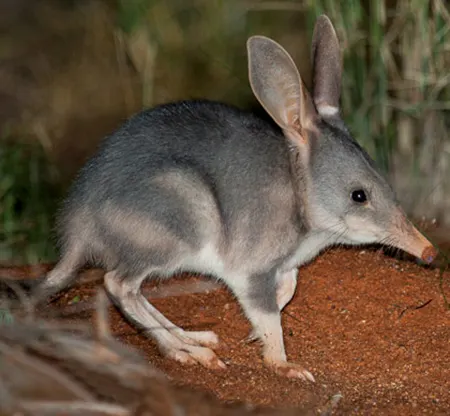
(Macrotis lagotis)
Greater Bilby
Білбі
It is found in South Australia, Western Australia, the Northern Territory, and New South Wales. Limited populations were also found in south-western Queensland.
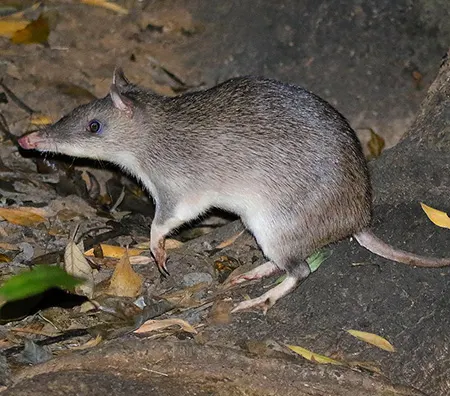
(Perameles nasuta)
Long-nosed Bandicoot
Бандикут довгоносий
It is distributed along the eastern coast of Australia from Cape York Peninsula in Queensland to New South Wales and Victoria.
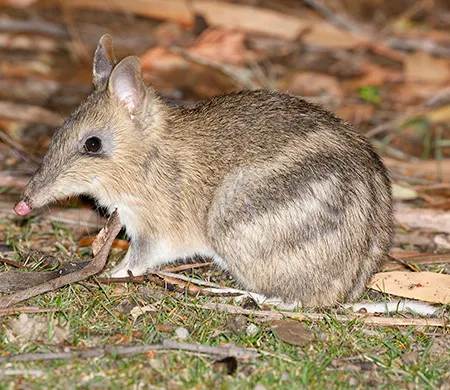
(Perameles gunnii)
Eastern Barred Bandicoot
Східний смугастий бандикут
It is endemic to south-eastern Australia, being native to the north-eastern Tasmania and mainland Victoria.
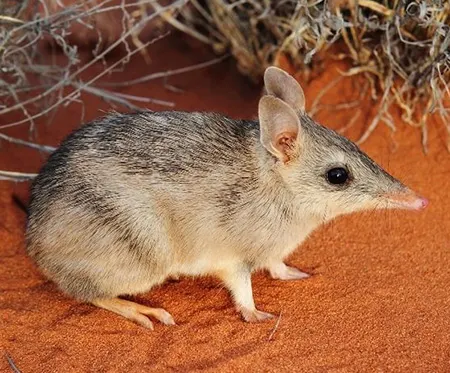
(Perameles bougainville)
Western Barred Bandicoot
Західний смугастий бандикут
The only surviving natural populations are on Bernier and Dorre islands in Shark Bay, Western Australia. Reintroduced back to mainland Australia to Heirisson Prong, Shark Bay.
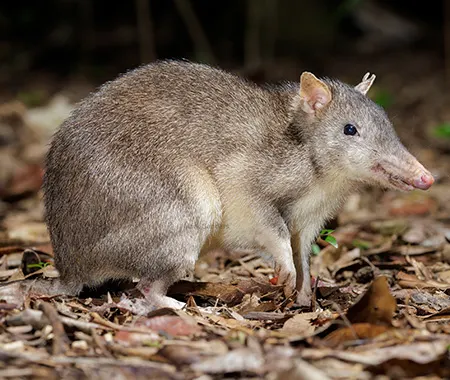
(Perameles pallescens)
Queensland Barred Bandicoot
Квінслендський бандикут
It is found in the north-eastern coastal region of Queensland, Australia.
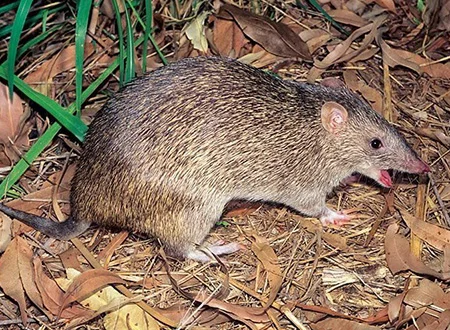
(Peroryctes broadbenti)
Giant Bandicoot
Гігантський бандикут
The type locality is Papua New Guinea, Central Province, banks of the Goldie River (a tributary of the Laloki River), inland from Port Moresby. It occurs at altitudes of 50–1,000 m.
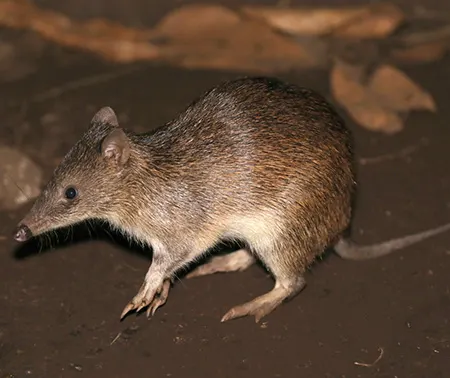
(Peroryctes raffrayana)
Raffray's Bandicoot
Бандикут Раффрея
It is found throughout the highlands of New Guinea, and on Japen Island. It occurs at altitudes of 50–3,900 m.
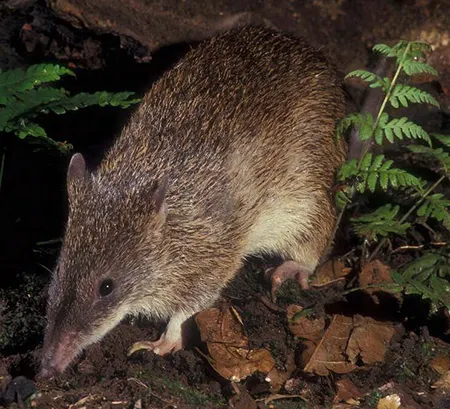
(Microperoryctes papuensis)
Mouse Bandicoot
Мишачий бандикут
It is endemic to Mount Sumuri in West Papua. It occurs at an altitude of 2,000 m.
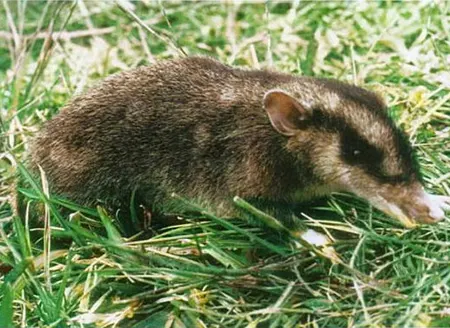
(Microperoryctes longicauda)
Striped Bandicoot
Довгохвостий бандикут
It is found in West Papua and Papua New Guinea. Its natural habitat is subtropical or tropical dry forests.
The genus (Microperoryctes) also includes: Papuan Bandicoot (Microperoryctes papuensis), Arfak Pygmy Bandicoot (Microperoryctes aplini).
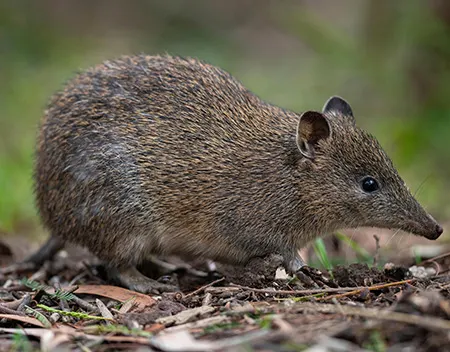
(Isoodon obesulus)
Southern Brown Bandicoot
Південний бурий бандикут
It is found in New South Wales, Victoria, mainland South Australia, Kangaroo Island, the Nuyts Archipelago, and Tasmania.

(Isoodon macrourus)
Northern Brown Bandicoot
Північний бурий бандикут
It is found only on the northern and eastern coasts of Australia and nearby islands, mainly Papua New Guinea.
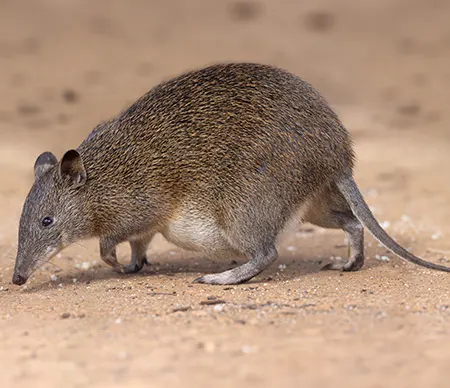
(Isoodon fusciventer)
Quenda
Квенда
It isendemic to Southwest Australia.
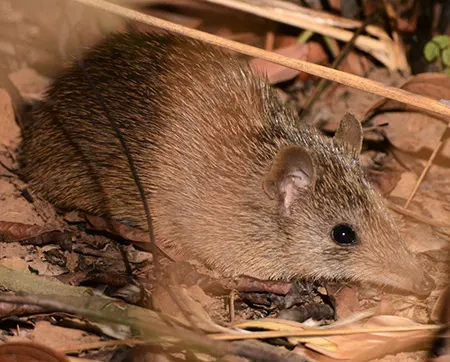
(Isoodon peninsulae)
Cape York Brown Bandicoot
Кейпйоркський бурий бандикут
It is found in northern Queensland, on the Cape York Peninsula.

(Isoodon auratus)
Golden Bandicoot
Золотистий бандикут
It is restricted to very small areas of Western Australia and the Northern Territory. Additional populations occur on Barrow, Middle, Augustus, Marchinbar, and Uwins Islands.
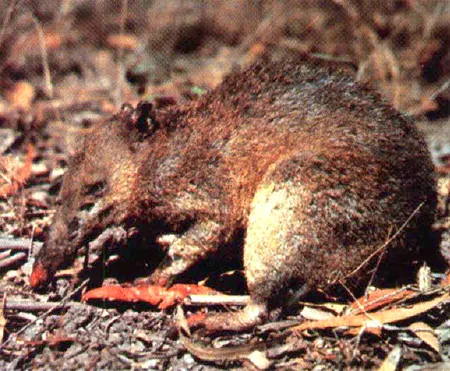
(Rhynchomeles prattorum)
Seram Bandicoot
Серамський бандикут
It is endemic to the island of Seram in Indonesia. It occurs at an altitude of 1,800 m.

(Echymipera rufescens)
Long-nosed Echymipera
Довгоносий колючий бандикут
It is found in Australia on the Cape York Peninsula, Indonesia, and Papua New Guinea.
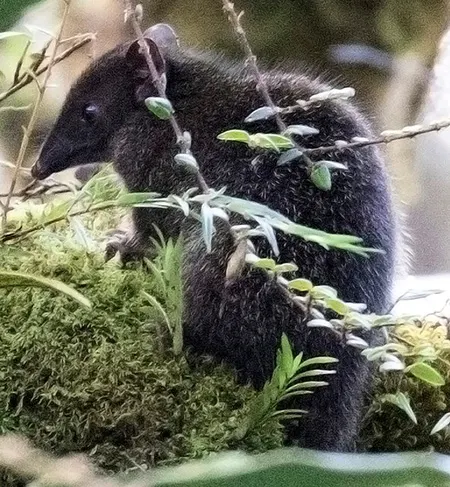
(Echymipera davidi)
David's Echymipera
Колючий бандикут Девіда
It is found on the island of Kiriwina, in the Trobriand Islands of Papua New Guinea, and may be present on other nearby islands also.
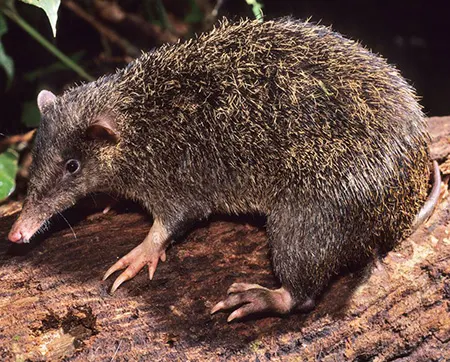
(Echymipera kalubu)
Common Echymipera
Плоскоголчастий колючий бандикут
It is native to New Guinea. It is found at elevations up to 2,000 m.
The genus (Echymipera) also includes: Clara’s Echymipera (Echymipera clara), Menzies’s echymipera (Echymipera echinista).
